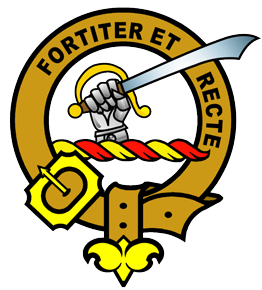Elliot Clan Crest
Elliot Clan Crest: An armoured hand holding a cutlass.
Elliot Clan Motto: Fortiter Et Recte (Boldly and Rightly).
Elliot Clan History:
The Elliots arrived in Teviotdale in the reign of Robert I and were soon established as one of the great 'riding clans' of the Scottish Borders. The Elliots of Redheugh appear as early as 1400, and, according to clan tradition, Robert Ellot of Redheugh, 10th Chief, was made Captain of a tower overlooking the Hermitage Water, north of Newcastleton. James, 15th Chief, was killed with James IV at the Battle of Flodden in 1513.
The name Elliot is one of a number of variants of an old Breton clan name. The Elliots, Alliots and Elligotts were members of the large Breton contingent in William the Conqueror’s army of 1066. All these names can be traced to Brittany. Several Breton families, including that of the Breton founder of the Stewart dynasty, from Dol, were among the Normans and Flemings brought to Scotland during the reigns of David I (1124-1153), Malcolm IV (1153-1165) and William the Lion ( 1165-1214).
This was a time when phonetic spelling was a matter of scribal choice. The most common other variant, in both Brittany and Great Britain, is that of Alliot, the name heard by a 12th century scribe who wrote this
name as Alyth, while other English speaking scribes spelt it as Alight and Alyght. When they heard the name spoken, 16th and 17th century cartographers who drew the first maps of Perthshire and Angus spelt the name
as Elieht and Eliot. These were the names given to the kirk, town and forest of Eliot, and shown on several maps in the National Library of Scotland. The old scribal name now appears on modern maps.
Some fourteen years after the forfeiture of his barony of the Brae in 1306, as a punishment for supporting Robert Bruce, Walter d’Elliot (the written, not spoken, name d’Alyth) and his clan, according to Scott of
Satchells, consisting of “twelve great families,” were relocated to Liddesdale by Bruce. The barony of the Brae had by the passed into the hands of John Brunyng, a man who had changed sides when later coming to the
support of Bruce. A DNA project has now confirmed the Breton origin of the Elliots, members of an ancient Celtic-Brittonic clan.
From 1565, there commenced a feud between the Elliots and the Scotts, after Scott of Buccleugh, the ancestor of the current Duke of Buccleuch, executed four Elliots for stealing cattle. In the following years, Border clan warfare and cattle thieving escalated with constant feuding between the Elliots, Maxwells, Pringles, Armstrongs, Kerrs and Johnstones, until James VI finally decided to put an end to it. Robert Eliott of Redheugh escaped to Fife and, as a result, Redheugh passed to his cousins, the Elliotts of Stobs.
Sir Gilbert Eliott of Stobs, was created a Nova Scotia baronet by Charles II, and was recognised as Chief of the Clan in 1673. His descendant, George Augustus Eliott defended Gibralter in 1782 and was created Lord Heathfield, the title becoming dormant within a generation.
Gilbert Elliot (1651-1718), who descended from a branch of the Stobs family was under forfeiture as an accessory to the Covenanters Rebellion of 1679, but following a full pardon was made a baronet and became a Lord of Session, taking the Scottish legal title of Lord Minto. The 2nd Baronet, another Gilbert, also became Lord of Session. The 3rd Baronet, became Lord of the Admiralty and Keeper of the Signet in Scotland, and the 4th Baronet, Viceroy of Corsica and Governor General of Bengal (1807-13). In 1813, he was created Baron Minto, Viscount Melgund and 1st Earl of Minto.
The 4th Earl of Minto (1847-1914) was appointed Governor-General of Canada before succeeding Lord Curzon as Viceroy of India in 1905. Jane Elliot (1727-1805), daughter of Gilbert Elliot, Lord Minto, wrote the words to The Flowers of the Forest. Walter Elliot (1888-1958) was Secretary of State for Scotland 1936-38.
From the 17th century, Eliot(t)s have been scattered around the world. but it was not until 1977 that the Eliot Clan Society came into being, formed by Sir Arthur Elliot of Stobs, 11th Baronet.
Surname distribution within Scotland: The highest concentrations of the Elliot name are in the Scottish Borders (Berwickshire, Peeblesshire, Roxburghshire, Selkirkshire and a portion of Midlothian), Dumfries and Galloway (Dumfriesshire, Kirkcudbrightshire and Wigtownshire), Edinburgh City and Lothian (Linlithgowshire, Edinburghshire, Haddingtonshire).
Places of Interest:
Hermitage Castle, situated in an isolated glen, north of Newcastleton, was part of a defence system which ran through Liddesdale. Hermitage Castle was held by the Elliot Chiefs as Captains.
Minto House, near Hawick. Home of the earls of Minto. Originally a 16th century fort, it was encased by a William Adam house in 1743, and altered by William Playfair in 1837. It was demolished amid much consternation
in 1992.
Redheugh, near Newcastleton, Roxburghshire. Except for two short periods, this has been held by the Eliott family since the 14th century.
Stobs Castle, near Hawick. Roxburghshire. Sold by the Eliotts in 1905.

